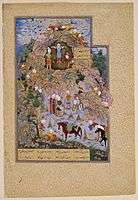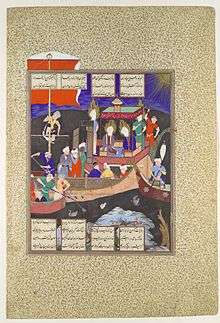Shahnameh of Shah Tahmasp

The Shahnamah of Shah Tahmasp (Persian: شاهنامه تهماسپی) or Houghton Shahnameh is one of the most famous illustrated manuscripts of the Shahnamah, the national epic of Greater Iran, and a high point in the art of the Persian miniature. It is probably the most fully illustrated manuscript of the text ever produced. As created, it had 759 pages, 258 with a miniature. The page size is about 48 x 32 cm, and the text written in nasta'liq script of the highest quality. It was broken up in the 1970s and pages are now in a number of collections.[1]
History
It was created in Tabriz at the order of Shah Ismail I of Persia, by the most prominent artists of the Safavid Persia, either intended as a gift to Suleiman the Magnificent, Sultan of the Ottoman Empire, or perhaps to celebrate the return of the your Tahmasp from a period as governor of Herat.[2] The work began in the 1520s before the death of Ismail I in 1524 and was completed almost twenty years later, in the reign of Shah Tahmasp. It was finally given to the then Ottoman Sultan, Selim II, in 1568, presented by a delegation. It remained in the Topkapi Palace Library in Istanbul until sold in the 20th century.
The manuscript once contained 258 miniatures, but was split up by Arthur Houghton II, and the miniatures sold individually. Houghton donated 78 paintings to the Metropolitan Museum of Art in 1972, and others were sold individually. These are in several collections, including the Khalil collection.[3]
On 6 April 2011, a page from this manuscript from the collection of the leading scholar of the manuscript, Stuart Cary Welch, was sold for 7.4 million pounds ($12 million).[4]
Miniatures
Many different artists worked on the project, including Mir Sayyid Ali, Sultan Mohammad, Mir Musavvir, Dust Muhammad, and probably Abd al-Samad,[5] and the style of the miniatures varies considerably, though the quality is consistently high. A number of artists have been identified from their style by scholars, but are not known by name.[6] The manuscript shows the fusion of the styles of the schools of Herat and the Turkmen-influenced painters of Tabriz.[7] Dust Muhammad wrote an account of Persian painting which mentions the manuscript, and is the first of many accounts to single out the Court of Guyumars (illustrated here), which he says is by Sultan Mohammad. Later scholars have called this miniature "matchless" and "probably the greatest picture in Iranian art".[8]
A famous unfinished miniature showing Rustam asleep, while his horse Rakhsh fights off a lion, was probably made for the manuscript, but was never finished and bound in, perhaps because its vigorous Tabriz style did not please Tahmasp. It appears to be by Sultan Mohammad, whose later works in the manuscript show a style adapted to the court style of Bizhad. It is now in the British Museum.[9]
-

The Death of Zahhak, by Sultan Mohammad
-

Parable of the "Ship of Fate"
-

Dust Muhammad, The Story Of Haftvad And The Worm
-

army crossing a river
Notes
- ↑ Leoni, Francesca. "The Shahnama of Shah Tahmasp: Heilbrunn Template of Art History". Metropolitan Museum of Art. Retrieved 13 February 2016.
- ↑ Piotrovsky and Rogers, 112
- ↑ Piotrovsky and Rogers, 112-117
- ↑ "16th century folio sets Islamic art auction record". reuters.com. Retrieved 13 February 2016.
- ↑ See his biography; there is some controversy over his contributions
- ↑ Piotrovsky and Rogers, 112-117
- ↑ Titley, 80
- ↑ Titley, 83; Welch, 17, both quoted
- ↑ Canby, 79-80
References
| Wikimedia Commons has media related to Shah Tahmasp's Shahnameh. |
- Blair, Sheila, and Bloom, Jonathan M., The Art and Architecture of Islam, 1250-1800, 1995, Yale University Press Pelican History of Art, ISBN 0300064659
- Canby, Sheila R., Persian Painting, 1993, British Museum Press, ISBN 9780714114590
- Piotrovsky M.B. and Rogers, J.M. (eds), Heaven on Earth: Art from Islamic Lands, 2004, Prestel, ISBN 3791330551
- Titley, Norah M., Persian Miniature Painting, and its Influence on the Art of Turkey and India, 1983, University of Texas Press, ISBN 0292764847
- Welch, Stuart Cary. Royal Persian Manuscripts, Thames & Hudson, 1976, ISBN 0500270740
Further reading
- Dickson M. B. and Welch S. C., The Houghton Shahnameh, 1981, Fogg Art Museum, Harvard University, Cambridge, Mass, 2 vols.
- Welch, Stuart Cary, A King's Book of Kings: The Shah-nameh of Shah Tahmasp, 1972, Metropolitan Museum of Art, ISBN 0870990284, 9780870990281
